January 2017 – As we toured Kanchanaburi with Mellow Adventures, visiting Erawan Waterfall and Huay Mae Khamin waterfall, we got a huge kick out of the road signs we saw. Familiar signs like “Stop” and “Railroad Crossing” took on a whole new look in the pretty Thai script.

Road signs in Thailand.
We asked our tour guide Mai what our names would look like in the Thai lettering, and she wrote them out for us. How cool!
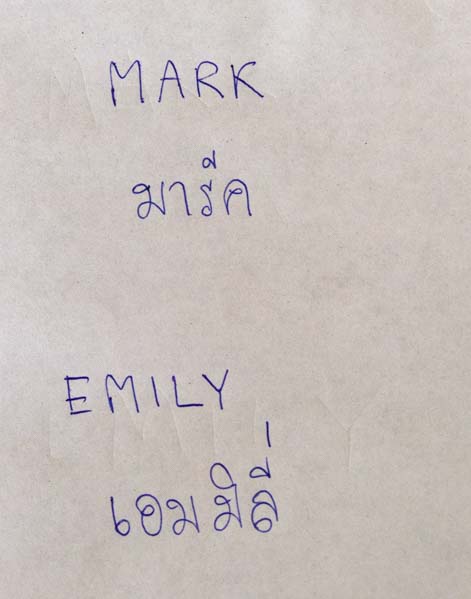
Mai wrote out our names in Thai letters – How beautiful!

Our tour guide Mai from Mellow Adventures
On this second day of touring with Mellow Adventures, we started off by paddling downstream in a kayak while Mai followed us downstream in a longtail boat. We were mesmerized by the haunting calls of the birds in the trees on either side of us as we paddled.

Kayaking in Kanchanaburi
We then made our way to Lawa Cave. The entrance to this cave sits at the top of a very long staircase, and just inside there was beautifully lit golden statue of Buddha with a rug in front of it for praying.

A beautiful golden statue of Buddha greets us at Lawa Cave.
We descended into the cave following a well lit trail.
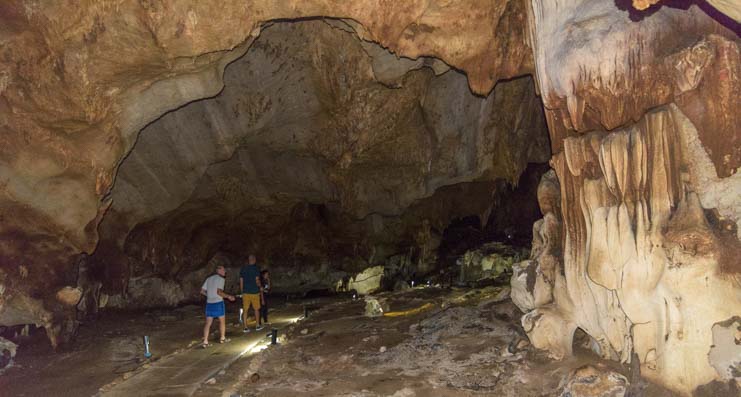
Heading into Lawa Cave.
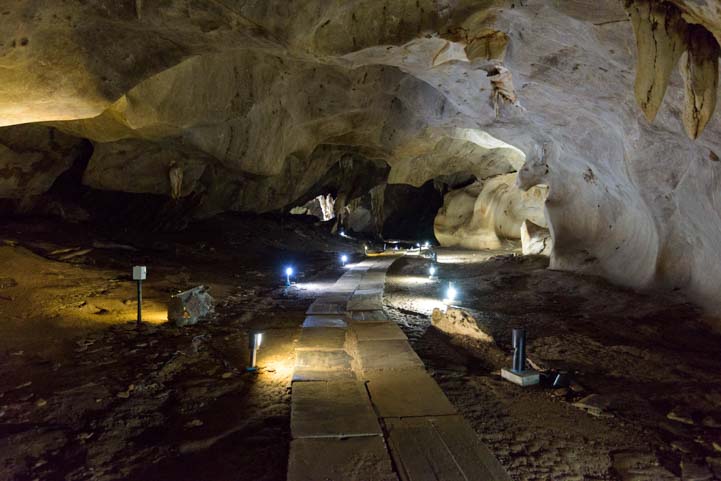
Lawa Cave.
There were lots of stalactites and stalagmites that made exotic sculpted patterns on the cave walls.
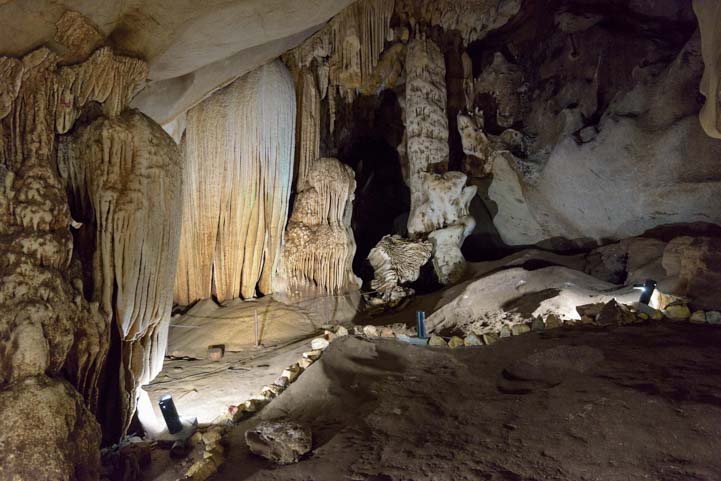
.
When we emerged from the cave, our guide Steffan noticed a woman selling fruits. She had a huge pile of what looked like gigantic pale green grapefruits in front of her.
“You’ve got to try these,” Steffen said excitedly. He said they were called “Som-oh” in Thai and he asked her to prepare one for us.
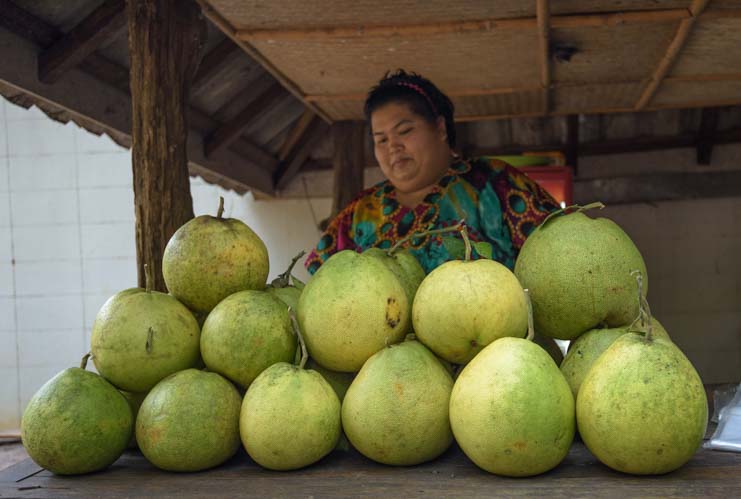
Bigger than a grapefruit and deliciously sweet: “Som oh” or polmelo fruits
She peeled back the rind to and then put the sections back inside. The sections were just like an orange or grapefruit, but so much bigger and very delicious. It was sweeter than a grapefruit and very tasty. I have never seen this citrus fruit before, but I found out it’s called “Polmelo.” Yum!!

Yum!
One of the really fun things about the jungle in Thailand is the unusual animals. Back on the road, we saw a monkey sign.

We hadn’t seen a road sign like this before!
And then we saw the real thing sitting in the middle of the road!
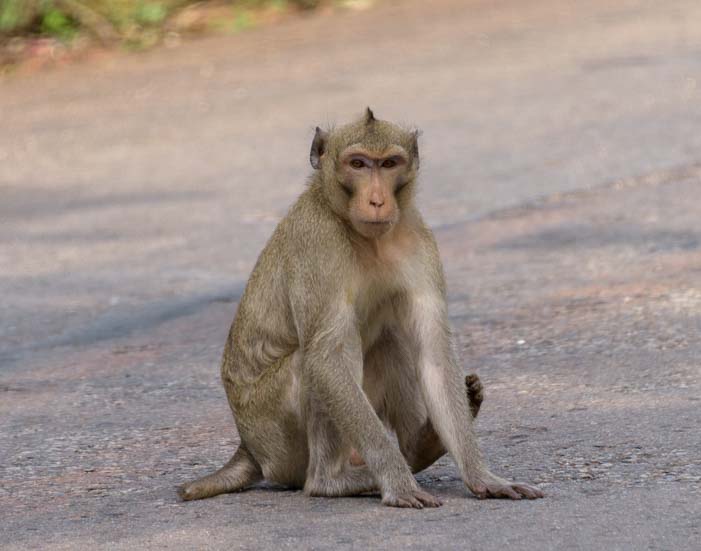
The greeter…
There was a whole pack of them — parents and babies — milling around the edges of the road. They were hoping for treats from tourists.

.
These were long tail monkeys, and Mai told us they have big teeth and can be pretty nasty.
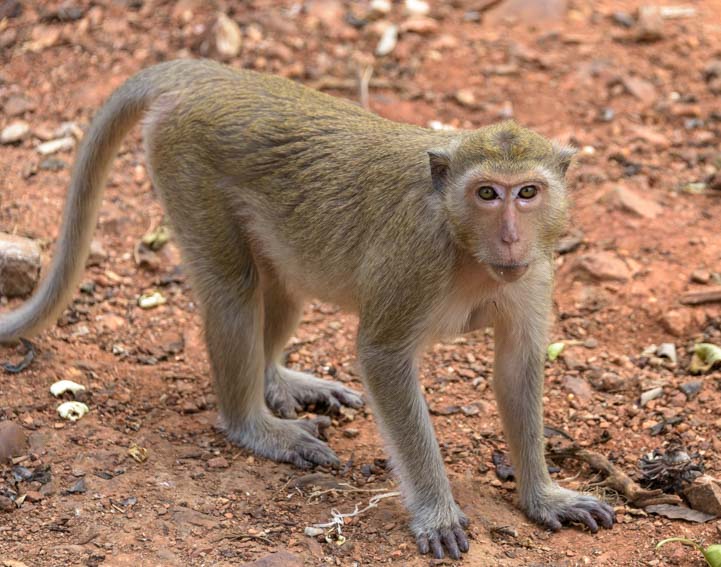
.
Fortunately, none of them came after us, and viewing them from a little distance out the car window they seemed very cute!
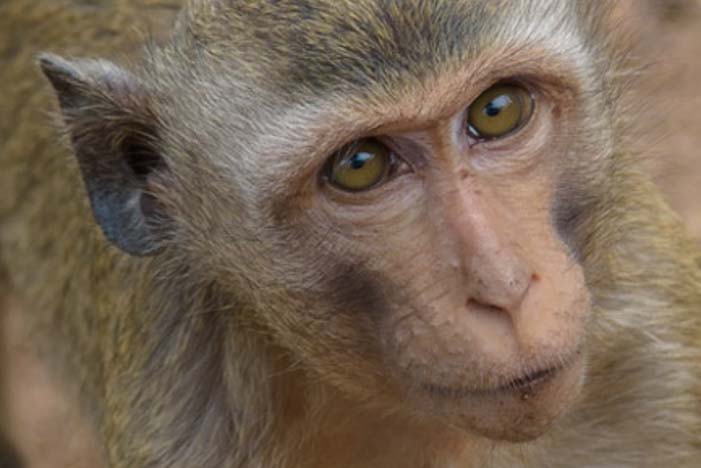
.
Our next stop was at a wonderful little coffee bistro that is built on a series of decks overlooking a river.

A gourmet espresso shop…in Thailand!!
It’s called the Rim Nam Cafe, and it’s owned by a young man named Oh. How wonderful it was to have a Hazelnut latte at this special spot!

Oh is the owner of Rim Nam Cafe.
Oh has created a wonderfully fanciful jungle retreat in the trees that is filled with unusual decorations and fun nooks and crannies that are perfect for curling up and reading a book or conversing with friends. Oh told us sometimes elephants come down for a drink at the water’s edge below!
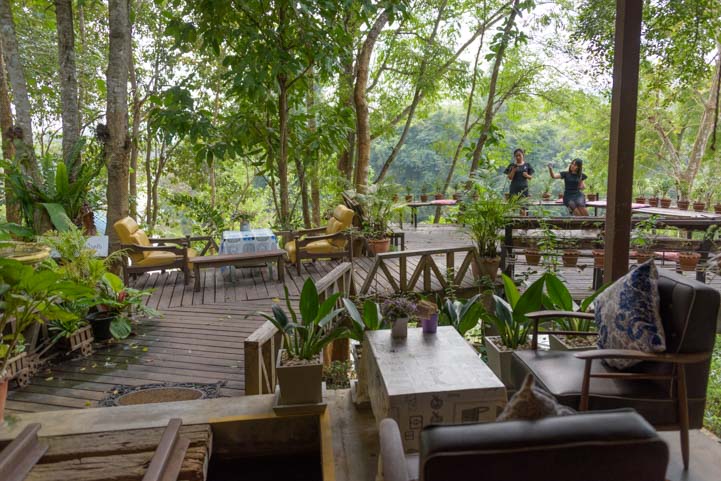
Wonderful outdoor seating overlooking the river.
The elephants didn’t show up while we were there, but we enjoyed roaming the grounds and taking photos.

Sometimes elephants come down to the river for a drink!
Among the intriguing decorations we found two blue letters, an M and an E. What a coincidence that these are our initials. We just had to get a selfie!!

We found an M and an E among other eclectic and creative decorations at Rim Nam cafe
The city of Kanchanaburi is the site of the bridge that was made famous by the book Bridge on the River Kwai (also a popular movie) which tells the story of the horrendous Japanese WWII labor camps that built a 258 mile long railway to enable the Japanese to transport goods and troops between the coast of Thailand (then called Siam) and Rangoon, Burma.
In early 1942, the Japanese seized the colony of Burma from the British, and they needed an overland shipping route to avoid the many Allied submarines lurking in the sea. Between the fall of 1942 and the fall of 1943, the rails were laid and over 600 bridges were constructed. It was a monumental feat to complete the railway so fast.
Some 120,000 (or as many as 300,000) southeast Asians laborers and another 61,000 British, Dutch and American POWs endured horrific conditions in these camps. 20% of the POWs died while as many as 50% of the southeast Asians laborers (who had been enticed to come for “easy work and good pay”) perished. It came to be known as the Death Railway.
When we had first arrived in Kanchanaburi by train a few days earlier, we had passed the cemetery where 6,982 POWs are buried. Another 5,310 POWs are buried in two other locations on the railway route.

Kanchanaburi cenetary for POWs who died building the Death Railway in 1942-43
The “Bridge on the River Kwai” itself was a modest bridge that crossed a calm river, but the story of the starvation, forced labor and massive death toll that went into the building of the railway was gut wrenching to ponder as we walked across the bridge from one side of the river to the other.

The Bridge over the River Kwai (pronounced “Kway”)
The heat right now in the “cool” winter season was stifling. The sweat just poured down our faces. As we looked back across the river, the area was filled with buildings and air conditioned civilization, and a tall statue of Buddha looked out over the river.
I can’t even imagine what it was like to bush-whack the jungle to lay these train tracks in the middle of nowhere with almost no food and filthy, contaminated water.
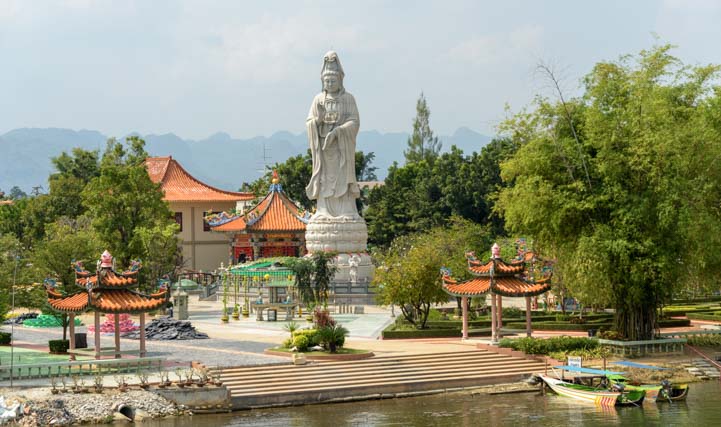
20% of the POWs died. As many as 50% of the SE Asian laborers died too.
There are two places to see parts of the Death Railway in Kanchanaburi, and our guides Steffen and Mai took us to another location about 30 miles away.
As we were discussing the Death Railway, Mai pointed out that the correct pronunciation for the word “Kwai” actually rhymes with the word “way” and not the word “why” as it is most commonly pronounced by English speakers.

Monks walk on the Death Railway.
A tourist train runs on these tracks and passes both points. It is actually the same train that we had taken from Bangkok to Kanchanaburi a few days earlier.

.
Tourists hung their heads out the window and snapped pics as they passed us.

.
The train continued along a bridge and disappeared around the bend.

The Death Railway.
There is a cave near this part of the Death Railway, and like Lawa Cave we had visited earlier, there was a golden statue of Buddha inside.

.
It is not a deep cave, but it was fun to look around.

Looking out of the cave towards the train tracks.
When choosing which places to visit on our trip to Thailand before we left, it was very difficult to narrow down the many incredible options of things to see and do.
Looking back now, our two days of tours of the waterfalls, caves and historic areas of Kanchanaburi with Mellow Adventures was one of the true highlights of our month-long trip.
There is more info in the links below.
Subscribe
Never miss a post — it’s free!
More info:
- Lawa Cave – Travel info from Bangkok Post
- Rim Nam Cafe – Facebook page
- Death Railway – Wikipedia
- An interview with a survivor of the Death Railway – A British survivor, age 95, in 2013
- Bridge over the River Kwai – 1952 book by Frenchman Pierre Boulle
- Bridge on the River Kwai – 1957 Hollywood Movie
- Railway Man – A 2014 movie on the Death Railway with a different twist
- Locations of Lawa Cave, Rim Nam Cafe and the Death Railway – Interactive Google Maps
- Mellow Adventures – Personalized, custom tours of Kanchanaburi, Thailand
(email Mellow Adventures here and see Tripadvisor reviews of Mellow Adventures here)
Other blog posts from our travels in Thailand:
- Snorkeling Ko Rok with Dive & Relax – Underwater Magic in Thailand!
- Cheow Lan Lake Tour in Khao Sok with Greenery Panvaree Floating Raft House
- Greenery Panvaree Floating Raft House – Khao Sok National Park… Wow!
- Huay Mae Khamin – Thailand’s Most Beautiful Waterfall – Mellow Adventures
- Erawan Falls – Jewel of Erawan National Park – with Mellow Adventures
- Train from Bangkok to Kanchanaburi – A Ride Through Thailand’s Countryside
- Damnoen Saduak Floating Market – Bangkok or Disney’s Epcot Center?
- One Day in Bangkok – A trip on the Chao Phraya Tourist Boat!
Our most recent posts:
- Is Forest River a Good RV? Well Built? Here’s Our Experience 06/20/25
- Sunset Crater Nat’l Monument – Lava & Camels at Bonito CG! 06/06/25
- 2024 Alpha Wolf 17CB Trailer – Our Goldilocks RV! 04/25/25
- Mogollon Rim, AZ – Cool Pines & Peaceful Willow Springs Lake 04/09/25
- Out with the Ram Diesel truck and In with a…?? 01/31/25
More of our Latest Posts are in the MENU.
New to this site? Visit RVers Start Here to find where we keep all the good stuff!!
<-Previous || Next->

Stunning!!! Thanks guys! Love you!
Thank you, Beth!!
Great post, as usual. Thank you for the information on the POW side of the railroad story.
Thanks, Pete. The story of the POWs is very sad, and the death rate is tragic. I was intrigued to learn that Americans made up only 1% of the total number of POWs, while about half were British and the other half was made up of Dutch and Australian POWs. But I was even more surprised by the staggering death toll of the non-POW Asians who worked alongside.
I remember visiting these places from living in Bangkok the early 70’s and appreciate the walk down memory lane. I recommend you try mangosteen before you leave – that was one of our favorite fruits that we never see here. Also recommend you don’t try durian – a very stinky fruit that is definitely an acquired taste.
I’m glad we’ve brought back good memories for you from 40 years ago, and I’m also glad to know the area hasn’t changed too much! We’ve actually had mangosteen juice in Arizona, and a few years ago we were very lucky to meet a Mexican in the state of Oaxaca who is teaching Oaxacan farmers how to grow not only mangosteen but many other exotic SE Asian tropical fruits and flowers which are far more profitable than corn (blog posts here and here). Luckily, we haven’t encountered any stinky fruit!!
Your link “An interview with a survivor of the Death Railway” led to the Telegraph article “Burma Railway: British POW breaks silence over horrors” which mentions the film The Railway Man and led me to Netflix to add that film to my queue. Thanks guyz.
Looks like an excellent movie too, James. Enjoy!
Wonderful post, great pictures. Love that beautiful cave. “Bridge over the river Kwai” was a very popular movie for my generation when it came out. Thanks for sharing that story and the links!
I haven’t yet seen that movie or the more recent one, Railway Man, but they have both received outstanding reviews and are surely both heartbreaking and insightful.
…great architectural beauty in those caves, but grim and tragic history reflects the profound price of conflict…
Beautifully said.